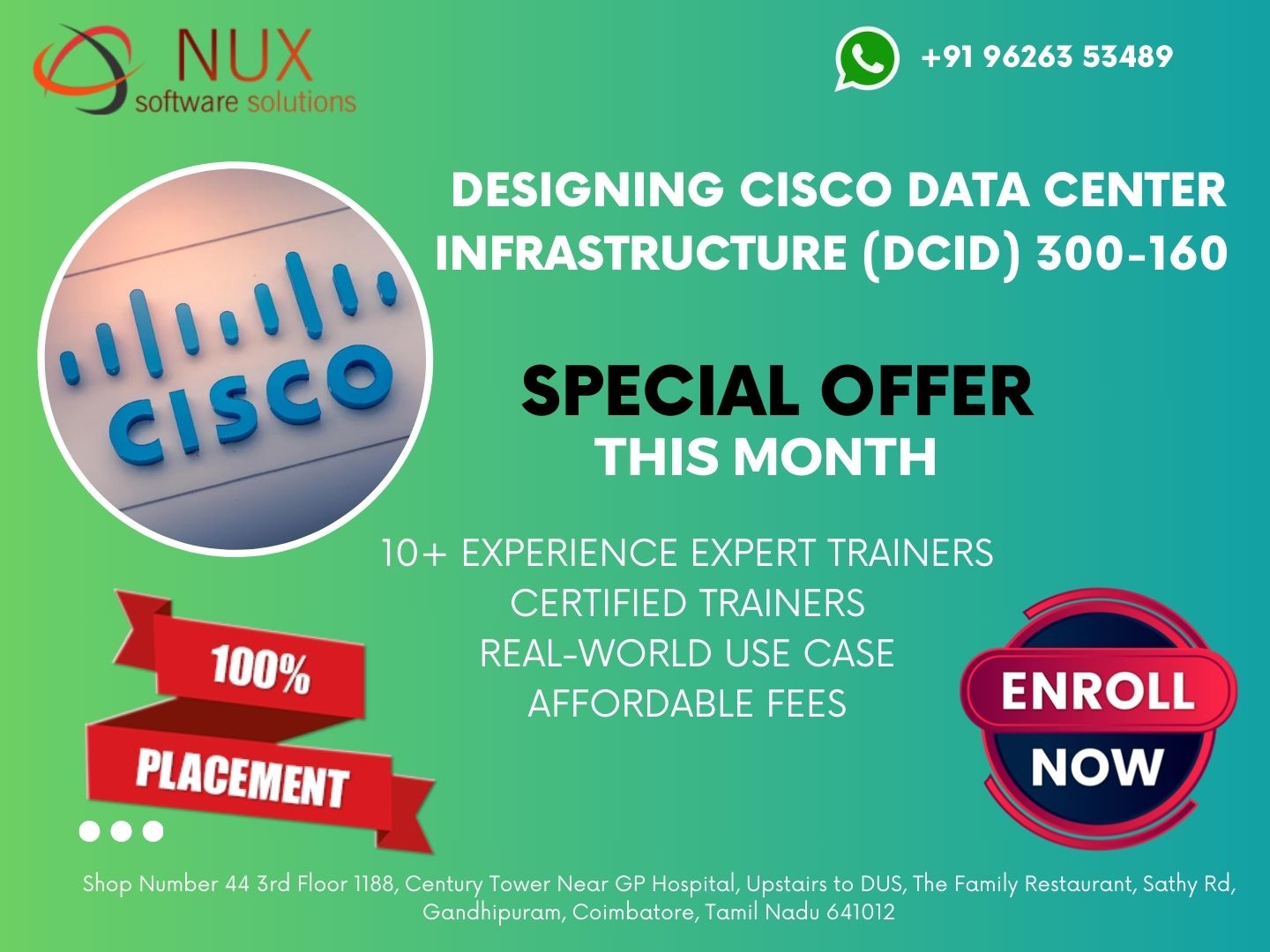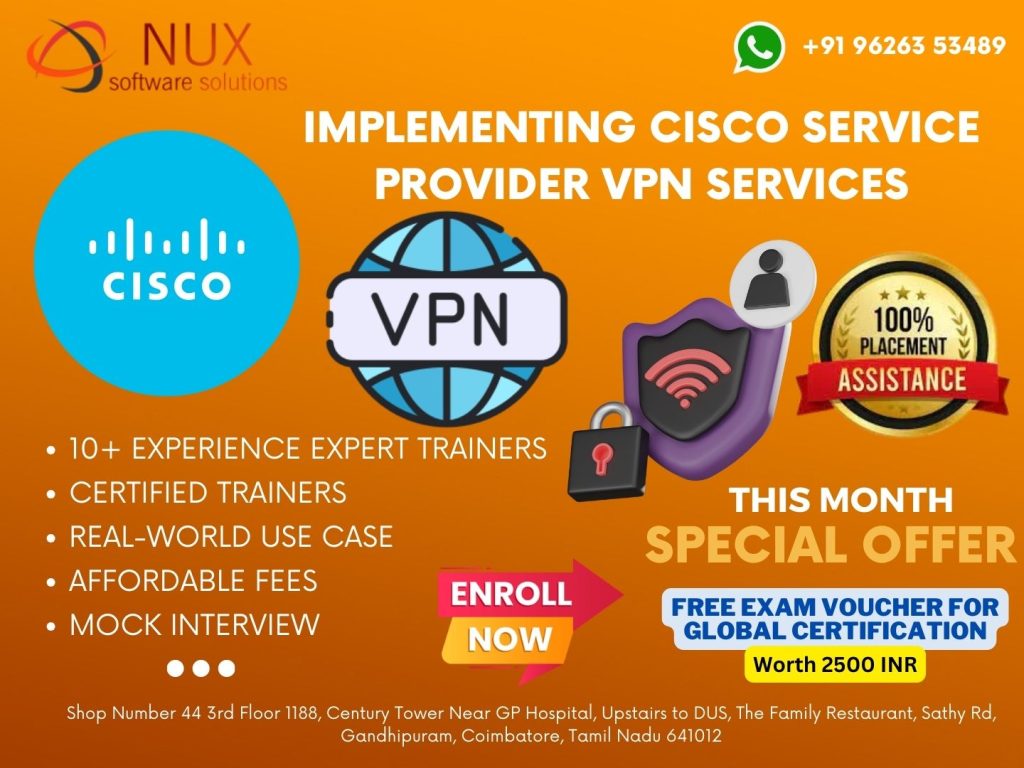Designing Cisco Data Center Infrastructure (DCID) 300-160

Cisco DCID 300-160 Training in Coimbatore
(Designing Cisco Data Center Infrastructure Certification)
Course Overview
The Designing Cisco Data Center Infrastructure (DCID 300-160) course is a key specialization for IT professionals who want to gain expertise in planning and designing scalable, resilient, and secure data center solutions using Cisco technologies. This course is part of the CCNP Data Center certification path, and it focuses on advanced design principles for networking, compute, virtualization, storage, and automation within a data center environment.
At Linux Training Center in Coimbatore, our DCID training blends expert instruction with hands-on labs, real-world case studies, and proven methodologies to help participants design enterprise-grade data centers that meet modern business and technical requirements.
Why Choose DCID 300-160?
Modern data centers require not just technical implementation but strategic architectural design to ensure performance, scalability, flexibility, and security. The DCID 300-160 course enables you to conceptualize, evaluate, and design Cisco-based solutions for physical and virtualized infrastructure, meeting both current and future demands of the business.
This course also lays the foundation for professionals preparing for CCNP and CCIE Data Center certifications, making it a vital investment in your IT career.
Who Should Enroll?
This course is designed for:
Network and Data Center Architects
Senior Network Engineers and Consultants
System Engineers and Infrastructure Designers
Candidates pursuing CCNP Data Center certification
Professionals responsible for designing end-to-end data center solutions
Prior understanding of Cisco data center technologies such as Nexus switching, UCS compute, and virtualization basics is recommended.
What You Will Learn
Design principles for data center networking and Layer 2/Layer 3 infrastructure
High availability and redundancy for data center topologies
Storage design, including Fibre Channel, FCoE, and iSCSI
Compute design using Cisco Unified Computing System (UCS)
Virtualization design using VMware, Hyper-V, and integration with Cisco platforms
Cisco Application Centric Infrastructure (ACI) design models
Security and segmentation design (firewalls, access policies, zoning)
Data center interconnect (DCI) strategies and multi-site architectures
Automation and orchestration design using Cisco UCS Director and scripting tools
Best practices for designing energy-efficient and scalable data centers
The course is focused on design best practices rather than configuration, helping engineers plan robust data center infrastructures before implementation.
Course Highlights
Delivered by Cisco-certified data center design experts
Based on Cisco’s official DCID exam blueprint
Comprehensive design scenarios and lab walkthroughs
Prepares students for the DCID 300-160 certification exam
Flexible training: classroom, online, or hybrid formats
Supports career progression to CCNP or CCIE Data Center certification
Career Opportunities
After completing the DCID course, you’ll be well-equipped to take on roles such as Data Center Design Engineer, Infrastructure Architect, Network Design Consultant, or Senior Systems Engineer. You will also be closer to achieving CCNP or CCIE Data Center certification, both of which are in high demand across enterprise and service provider sectors.
Why Linux Training Center, Coimbatore?
At Linux Training Center, we provide in-depth, career-focused training that goes beyond certification. Our DCID course is designed to help you understand how to architect future-ready data center environments, ensuring that your designs meet real-world scalability, performance, and security needs.
Designing Cisco Data Center Infrastructure (DCID) 300-160 Syllabus
Data Center Network Connectivity Design - 24%
1 Evaluate options for Layer 2 connectivity to meet deployment requirements in the data center
a) Endpoint mobility
b) Redundancy / high availability
c) Convergence
d) Services insertion
2 Evaluate options for Layer 3 connectivity to meet deployment requirements in the data center
a) IP mobility
b) Redundancy / high availability
b) [i] Graceful restart / NSF
c) Convergence
d) Services insertion
d) [i] Load balancing
d) [ii] Security
Data Center Infrastructure Design - 21%
1 Evaluate data center protocols to meet deployment requirements
a) Fabric Path
b) OTV
c) VXLAN
d) LISP
e) VPC/VPC+
2 Evaluate options for orchestration and management in a data center
a) Orchestration and automation
b) Out-of-band management network
c) License management
3 Evaluate options for device and routing virtualization in a data center
a) VDC
b) VRF
4 Evaluate options for interconnecting data centers
Data Center Storage Network Design - 21%
1 Plan for iSCSI deployment in the data center
a) Multipathing
b) Addressing schemes
2 Evaluate QoS requirements in the data center
a) Fibre Channel
b) FCoE
c) FCIP
d) iSCSI
3 Determine FCoE/ Fibre Channel interface parameters based on data center requirements
a) Dedicated and shared mode
b) Port types
c) ISL
d) Oversubscription
4 Evaluate SAN Topology options in the data center
a) Fabric redundancy
b) NPV, NPIV, and FCF
c) Load balancing
Data Center Compute Connectivity Design - 19%
1 Evaluate options for Ethernet connectivity to meet deployment requirements in a data center
a) Redundancy / high availability
b) Bandwidth
b) [i] Over subscription
c) Fabric interconnect operation mode
c) [i] Switch mode
c) [ii] End host mode
2 Evaluate options for storage connectivity to meet deployment requirements in a data center
a) Multipathing
b) Bandwidth
b) [i] Port channels
b) [ii] Oversubscription
c) Fabric interconnect operation mode
c) [i] Switch mode
c) [ii] End host mode
d) Direct-attached storage
d) [i] Appliance port
d) [ii] Fibre Channel storage port
d) [iii] FCoE port
Data Center Compute Resource Parameters Design - 15%
1 Evaluate options for orchestration and automation in the data center
a) Service profile templates
b) vNIC templates
c) vHBA templates
d) Global policies vs local policies
2 Evaluate options for management network in a data center
a) In-band
b) Out-of-band
3 Evaluate options for network device virtualization in a data center
a) Cisco VIC adaptors
a) [i] Number of interfaces vs IOM uplinks
a) [ii] vCon placement policies
a) [iii] Ethernet adaptor policies
a) [iv] Fibre Channel policies



